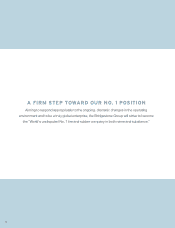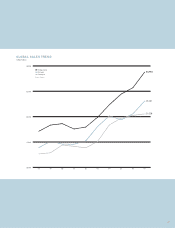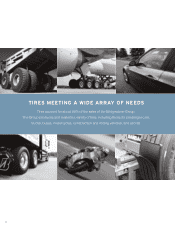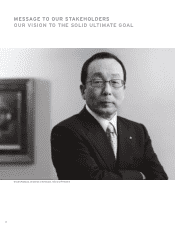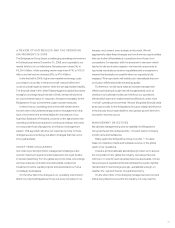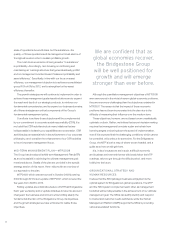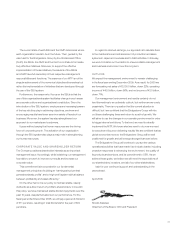Bridgestone 2008 Annual Report Download - page 9
Download and view the complete annual report
Please find page 9 of the 2008 Bridgestone annual report below. You can navigate through the pages in the report by either clicking on the pages listed below, or by using the keyword search tool below to find specific information within the annual report.A REVIEW OF OUR RESULTS AND THE OPERATING
ENVIRONMENT IN 2008
The Bridgestone Group faced a challenging operating environment
in the scal year ended December 31, 2008, and, regrettably, our
results fell short of our initial plans. Net sales were down 5%, to
¥3,234.4 billion, while operating income was down 47%, to ¥131.6
billion, and net income declined 92%, to ¥10.4 billion.
In the rst half of 2008, higher raw material and energy costs
put pressure on prots. In the second half, natural rubber and
crude oil prices began to decline, while the yen appreciated rapidly.
The nancial crisis in the United States triggered a global economic
recession, and beginning in the fall of 2008, demand declined at
an unprecedented pace. In response, it became necessary for the
Bridgestone Group to implement urgent countermeasures.
I believe that our operating environment will remain severe
for some time. My fundamental approach to management in this
type of environment is to reemphasize the importance of our
business’ Basics and Principles, proceed on the assumption that
operating conditions are subject to continuous change, and strive
to incorporate those changes into an enhanced management
system. This approach will drive our response not only to those
changes we are now facing, but also to changes that may occur
in the years ahead.
SHORT-TERM CHALLENGES
Our most important short-term management challenge is the
need to implement urgent countermeasures to the rapid decline
in demand stemming from the global economic crisis. Accordingly,
we have reduced production at certain plants, postponed
investment in some capital projects, and accelerated our focus
on strategic businesses.
On the other hand, the changes in our operating environment
affect not only the Bridgestone Group but every company in our
industry, and, indeed, every industry in the world. We will
aggressively utilize these changes and turn them into opportunities
that can further differentiate our operations from those of our
competitors. For example, with the slowdown in demand—which
has led to idle production capacity—we have the opportunity to
rigorously reevaluate production capabilities and processes in a
manner that is simply not possible when our capacity is fully
engaged. This opportunity will enable us to dramatically improve
production efciencies while enhancing quality.
Furthermore, we will study ways to increase management
efciency (including through internal reorganization), work to
develop new business models, and reinforce our operations,
efforts which cannot be implemented as effectively under more
“normal” operating environments. We see this global nancial crisis
as an opportunity for the Bridgestone Group to enlarge its inuence
in the industry and prepare itself for even greater growth when the
economic recovery occurs.
MANAGEMENT OBjECTIVES
My ultimate management goal is to establish the Bridgestone
Group as the world’s undisputed No. 1 tire and rubber company
in both name and substance.
Many regard the Bridgestone Group to be No. 1 “in name”
based on objective criteria such as sales revenue or the global
reach of our operations.
Tires are an internationally standardized product, so to survive
the competition in the global tire industry, we believe that, at a
minimum, in order for such an enterprise to be successful, it must
have a scope of operations that can address the needs of global
demand and it must be large enough—substantial enough—to
weather the “ups and downs” of a global economy.
On the other hand, in the changing management environment
that is being faced by the entire tire industry, not only must the
07




